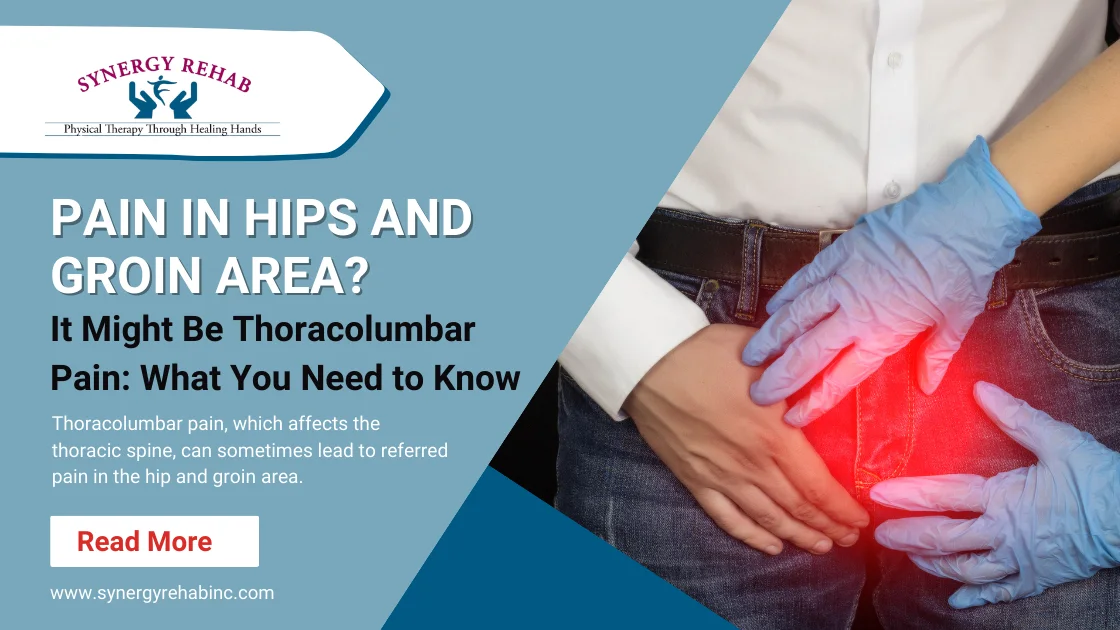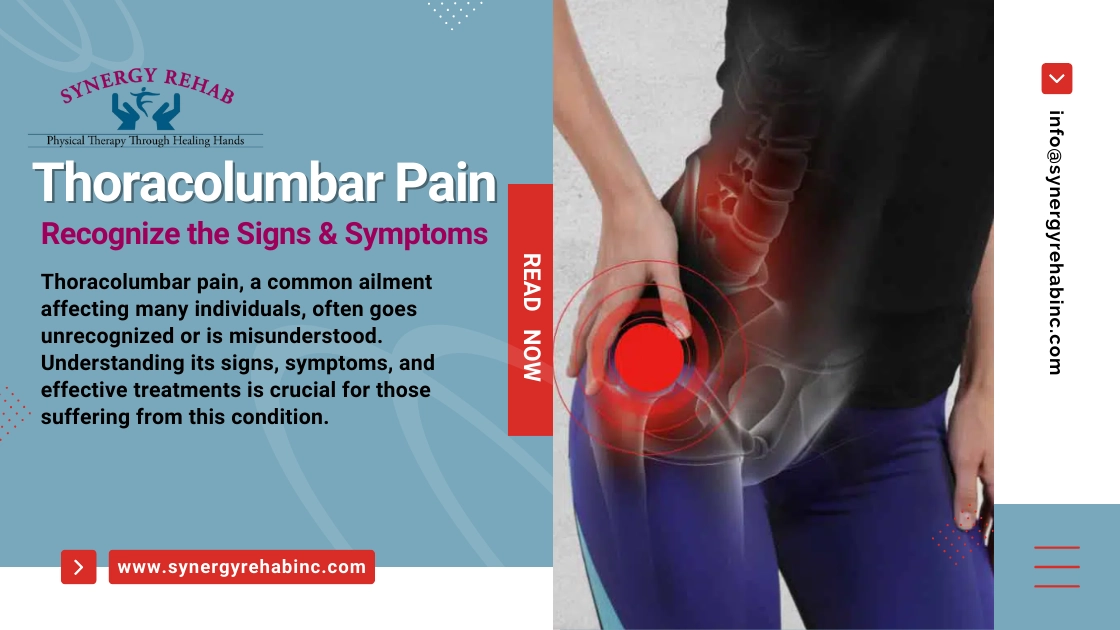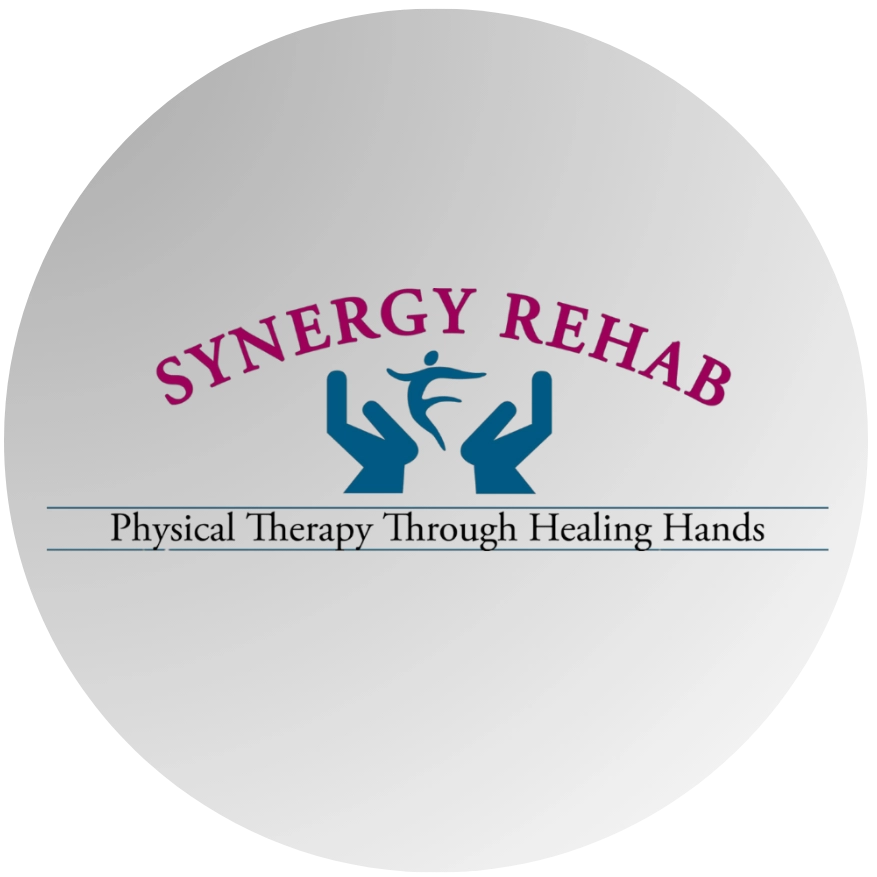Pain in Hips and Groin Area? It Might Be Thoracolumbar Pain: What You Need to Know
Are you experiencing discomfort in your groin and hip area? It’s possible that what you’re feeling is thoracolumbar pain. Groin and hip discomfort can sometimes be attributed to thoracolumbar pain, a condition that affects the thoracic spine located at the back of the chest and extends from the bottom of the neck to the start of the lumbar spine. This type of pain, although not the most common form of back pain, can have serious causes and should not be ignored. Let us understand what thoracolumbar pain is, its causes, symptoms, and why physical therapy might be your best bet for relief. What is Thoracolumbar Pain Thoracolumbar pain affects the thoracic spine at the back of the chest, extending from the neck to the start of the lumbar spine. This type of pain can feel like a stabbing sensation and, though not the most common, can signal underlying issues. Causes of Thoracolumbar Pain Inflammation: The most common cause, which can stem from a sudden sprain or strain, poor posture, prolonged sitting, lack of muscular strength, or repetitive movements involving the thoracic spine. Less Common Causes: These include thoracic stenosis, slipped discs, vertebral fractures, osteoporosis, spinal infection, shingles, spinal osteoarthritis, ankylosing spondylitis, Scheuermann’s disease, and spinal tumors. Symptoms and Diagnosis Symptoms: Pain in the thoracic spine is often described as a stabbing sensation. Red flag symptoms include serious injury, persistent or worsening pain, changes in spine shape, numbness or weakness in the legs, and incontinence, among others. Diagnosis: For persistent, severe pain, especially with ‘red flag’ features, clinicians may suggest tests like blood work, X-rays, and MRI scans. What is the relation between thoracolumbar pain and hip and groin discomfort? Thoracolumbar pain, which affects the thoracic spine, can sometimes lead to referred pain in the hip and groin area. This occurs because the nerves in the thoracic spine can affect other parts of the body, including the hips and groin. Men and women both can suffer from this type of pain. When there’s an issue in the thoracic spine, such as inflammation or nerve compression, it can manifest as pain or discomfort in these areas. This relationship highlights the interconnectedness of the spine and other body regions, making accurate diagnosis and targeted treatment, such as physical therapy, crucial for relief. What is referred pain? Referred pain is a phenomenon where pain is perceived in an area of the body that is distant from the actual source of the pain. This occurs because the nerve pathways from different parts of the body often converge as they enter the spinal cord and travel up to the brain. As a result, the brain may have difficulty pinpointing the exact source of the pain and mistakenly interprets it as coming from a different location. This is why issues in one part of the body can lead to pain sensations in another area. This explains the relationship between the thoracolumbar pain and pelvic discomfort better. How Physical Therapy Helps with Hip and Groin Area Pain Physical therapy for thoracolumbar pain is relevant to hip and groin area pain because the thoracic and lumbar regions of the spine are interconnected with nerves that affect the hips and groin. it targets the underlying causes of discomfort rather than just alleviating symptoms. Physical therapy for groin pain includes: Strengthening Exercises: These build support in the spine and hip region, reducing strain. Flexibility Training: Enhances range of motion, reducing stiffness and discomfort in hips and groin. Posture Improvement: Correct posture reduces stress on the spine and, by extension, the hips and groin. Pain Management Techniques: Used in physical therapy for hip pain and groin can directly target and alleviate hip and groin pain linked to thoracolumbar issues. Many individuals have endured years of groin pain, often trying various treatments without lasting relief. However, a significant number have found a successful remedy in physical therapy. This approach, focusing on the interconnectedness of the thoracolumbar spine, hips, and groin, offers exercises and techniques specifically tailored to address the root causes of their discomfort. By strengthening and increasing the flexibility of relevant muscle groups, improving posture, and utilizing targeted pain management strategies, the best physical therapist in Southfield has provided these individuals with a much-needed path to recovery and a return to a more comfortable, active lifestyle. Find the Right Remedy Are you in Southfield, Michigan, and struggling with persistent groin or hip pain? Don’t let discomfort dictate your life. Synergy Rehab offers a specialized physical therapy program tailored to address thoracolumbar pain, which could be the root cause of your distress. Our expert team is dedicated to providing personalized care that focuses on strengthening, flexibility, and pain management, aimed at bringing long-term relief and improved quality of life. Take your first step towards a pain-free future – contact Synergy Rehab today and discover the transformative power of physical therapy!
Thoracolumbar Pain: Recognize the Signs & Symptoms
Thoracolumbar pain, a common ailment affecting many individuals, often goes unrecognized or is misunderstood. Understanding its signs, symptoms, and effective treatments is crucial for those suffering from this condition. This comprehensive guide aims to shed light on thoracolumbar pain, helping you identify and address it effectively. What is Thoracolumbar Fascia Pain? The thoracolumbar fascia is a vital component of the body’s musculoskeletal system, located in the lower back region. It is composed of connective tissue and extends across the lower part of the spine, covering the thoracic and lumbar areas. This fascia plays a crucial role in various bodily functions: Image Source: Physioroom Given its extensive use and importance in daily activities like bending, twisting, and lifting, the thoracolumbar fascia is highly susceptible to overuse and strain. This can lead to inflammation, stiffness, and pain in the area, known as thoracolumbar fascia pain. This condition can significantly impact mobility and quality of life, necessitating proper care and treatment. Recognizing the Signs and Symptoms Recognizing the signs and symptoms of thoracolumbar fascia pain is essential for timely and effective treatment. Key symptoms include: Effective Treatments for Thoracolumbar Pain Physical Therapy and Rehabilitation Image Source: Physiopedia Effective treatment of thoracolumbar pain often involves a multifaceted approach, with physical therapy and rehabilitation playing a central role. Here’s a more detailed look into how these treatments work: These therapies are tailored to individual needs and are often more effective when combined, addressing not just the symptoms but also the underlying causes of thoracolumbar pain. Core Stability Exercises specifically target the muscles in the trunk and lower back, playing a vital role in maintaining proper posture and spinal alignment. By strengthening these deep muscles, core stability exercises help to stabilize the spine, reducing strain on the thoracolumbar fascia and thereby alleviating thoracolumbar pain. Image Source: MDPI Myofascial Release Techniques, on the other hand, involve applying gentle, sustained pressure to the myofascial connective tissue to eliminate pain and restore motion. This method is particularly effective in treating issues related to fascial adhesions – areas where the fascia has become stiff or stuck, causing pain and restricting movement. When combined, core stabilization exercises and myofascial release techniques offer a comprehensive approach to treating lower back pain, especially in older adults. This combination not only helps in pain relief but also in improving the functional status of the back, making it a highly effective regimen for managing thoracolumbar pain. Lifestyle Adjustments for Managing Thoracolumbar Pain In addition to medical treatments, certain lifestyle adjustments can significantly alleviate thoracolumbar pain: Conclusion Thoracolumbar pain, though common, requires proper understanding and management. By recognizing its symptoms and seeking appropriate treatments, including physical therapy and lifestyle adjustments, individuals can effectively manage and alleviate this discomfort. Remember, early recognition and intervention are key to preventing the progression of thoracolumbar pain. If you’re struggling with thoracolumbar pain and seeking effective, personalized care, Synergy Rehab Inc. in Southfield is here to help. Our expert team specializes in physical therapy, core stability exercises, and myofascial release techniques tailored to your unique needs. Don’t let back pain hold you back any longer. Contact us today to start your journey toward pain relief and a healthier, more active lifestyle. Let us be your partner in managing and overcoming thoracolumbar pain. Call or visit our website to schedule your appointment with Synergy Rehab Inc. – your first step towards lasting back pain relief.




